Project Report: Strategies for Diversity and Inclusion at Aviva PLC
VerifiedAdded on 2023/01/19
|27
|5904
|48
Report
AI Summary
This report presents a comprehensive project management plan focused on improving diversity and inclusion within Aviva PLC, a multinational insurance company. The report outlines the project's aims, objectives, and timeframes, including a detailed project management plan covering cost, scope, time, quality, resources, communication, and risk. It incorporates a work breakdown structure and Gantt chart to ensure timely completion. The research employs both qualitative and quantitative methods, utilizing questionnaires to gather primary data and online sources for secondary data. The report explores the concept of equality and diversity in the workplace, identifies challenges faced by Aviva PLC, and proposes strategies to build an inclusive workforce. The research also includes a discussion of sampling techniques and data sources, aiming to provide actionable recommendations for Aviva PLC to foster a diverse and equitable workplace.
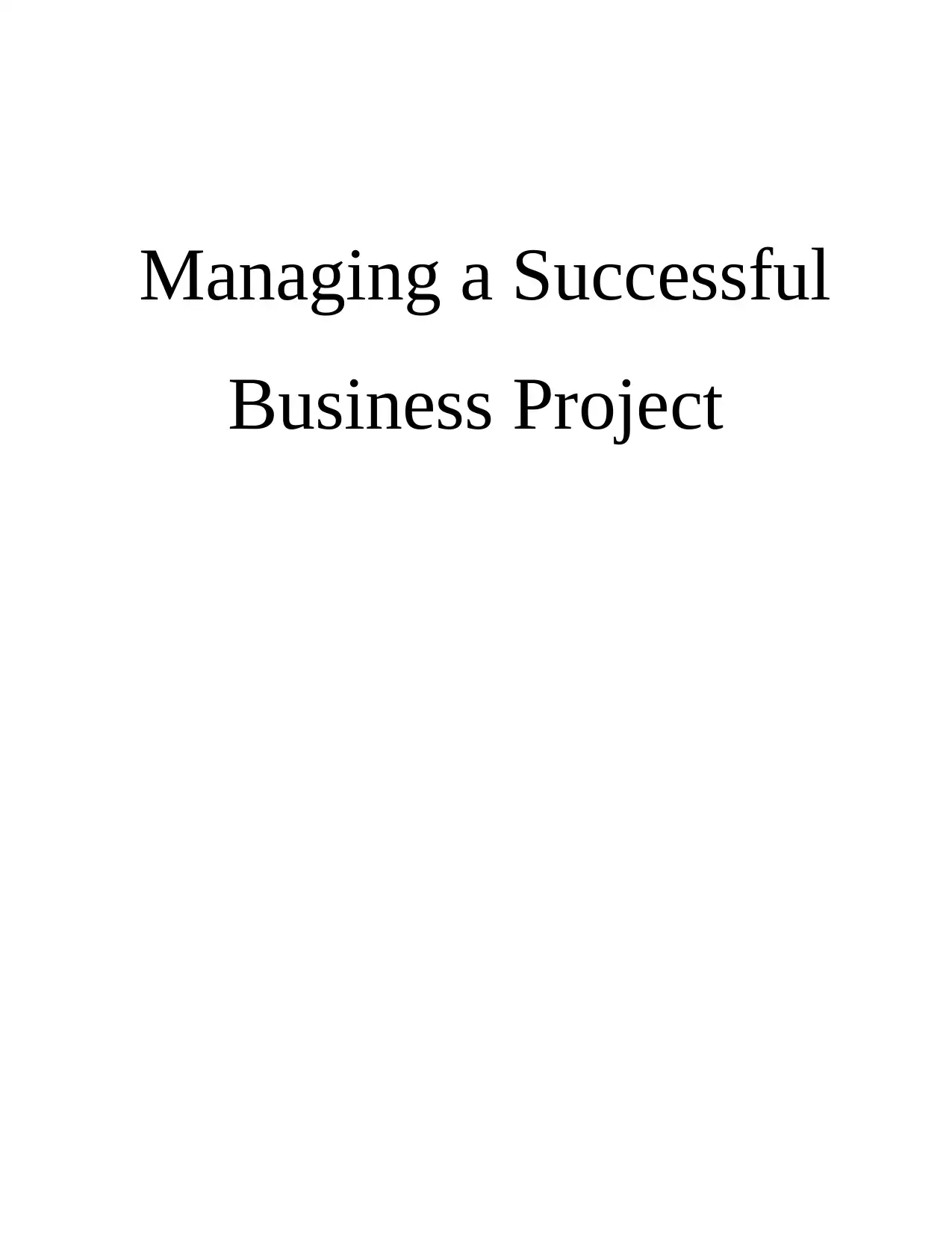
Managing a Successful
Business Project
Business Project
Paraphrase This Document
Need a fresh take? Get an instant paraphrase of this document with our AI Paraphraser
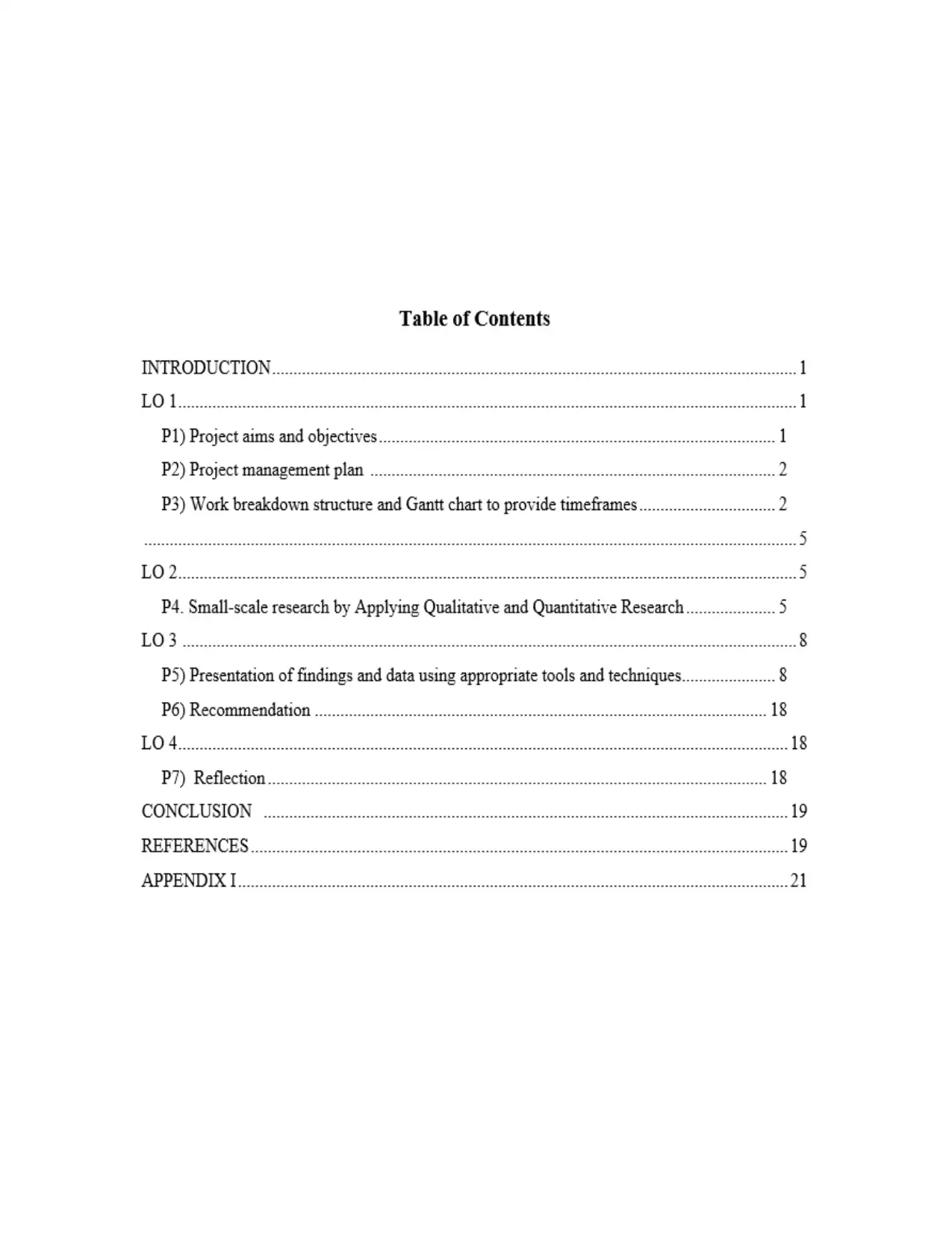

⊘ This is a preview!⊘
Do you want full access?
Subscribe today to unlock all pages.

Trusted by 1+ million students worldwide
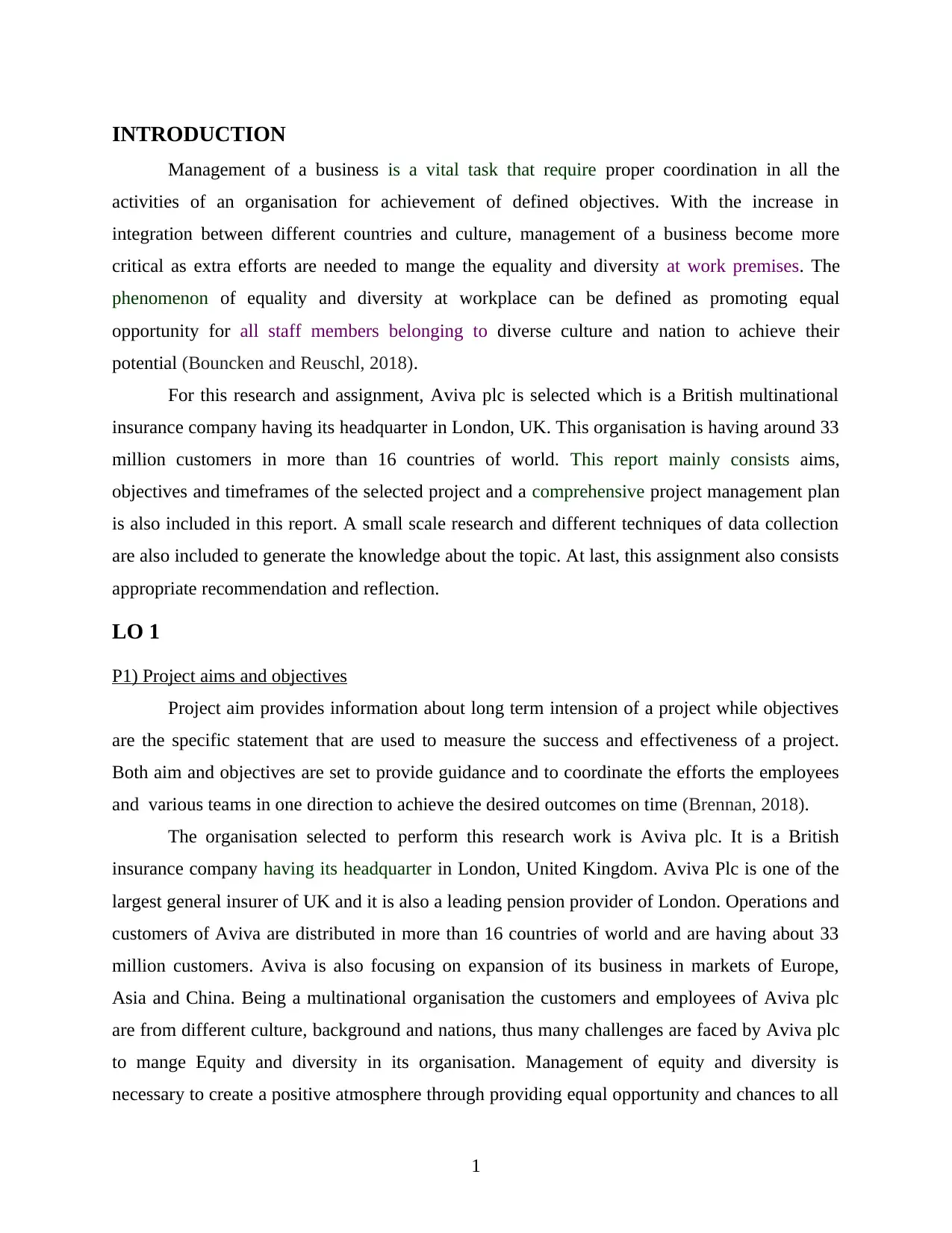
INTRODUCTION
Management of a business is a vital task that require proper coordination in all the
activities of an organisation for achievement of defined objectives. With the increase in
integration between different countries and culture, management of a business become more
critical as extra efforts are needed to mange the equality and diversity at work premises. The
phenomenon of equality and diversity at workplace can be defined as promoting equal
opportunity for all staff members belonging to diverse culture and nation to achieve their
potential (Bouncken and Reuschl, 2018).
For this research and assignment, Aviva plc is selected which is a British multinational
insurance company having its headquarter in London, UK. This organisation is having around 33
million customers in more than 16 countries of world. This report mainly consists aims,
objectives and timeframes of the selected project and a comprehensive project management plan
is also included in this report. A small scale research and different techniques of data collection
are also included to generate the knowledge about the topic. At last, this assignment also consists
appropriate recommendation and reflection.
LO 1
P1) Project aims and objectives
Project aim provides information about long term intension of a project while objectives
are the specific statement that are used to measure the success and effectiveness of a project.
Both aim and objectives are set to provide guidance and to coordinate the efforts the employees
and various teams in one direction to achieve the desired outcomes on time (Brennan, 2018).
The organisation selected to perform this research work is Aviva plc. It is a British
insurance company having its headquarter in London, United Kingdom. Aviva Plc is one of the
largest general insurer of UK and it is also a leading pension provider of London. Operations and
customers of Aviva are distributed in more than 16 countries of world and are having about 33
million customers. Aviva is also focusing on expansion of its business in markets of Europe,
Asia and China. Being a multinational organisation the customers and employees of Aviva plc
are from different culture, background and nations, thus many challenges are faced by Aviva plc
to mange Equity and diversity in its organisation. Management of equity and diversity is
necessary to create a positive atmosphere through providing equal opportunity and chances to all
1
Management of a business is a vital task that require proper coordination in all the
activities of an organisation for achievement of defined objectives. With the increase in
integration between different countries and culture, management of a business become more
critical as extra efforts are needed to mange the equality and diversity at work premises. The
phenomenon of equality and diversity at workplace can be defined as promoting equal
opportunity for all staff members belonging to diverse culture and nation to achieve their
potential (Bouncken and Reuschl, 2018).
For this research and assignment, Aviva plc is selected which is a British multinational
insurance company having its headquarter in London, UK. This organisation is having around 33
million customers in more than 16 countries of world. This report mainly consists aims,
objectives and timeframes of the selected project and a comprehensive project management plan
is also included in this report. A small scale research and different techniques of data collection
are also included to generate the knowledge about the topic. At last, this assignment also consists
appropriate recommendation and reflection.
LO 1
P1) Project aims and objectives
Project aim provides information about long term intension of a project while objectives
are the specific statement that are used to measure the success and effectiveness of a project.
Both aim and objectives are set to provide guidance and to coordinate the efforts the employees
and various teams in one direction to achieve the desired outcomes on time (Brennan, 2018).
The organisation selected to perform this research work is Aviva plc. It is a British
insurance company having its headquarter in London, United Kingdom. Aviva Plc is one of the
largest general insurer of UK and it is also a leading pension provider of London. Operations and
customers of Aviva are distributed in more than 16 countries of world and are having about 33
million customers. Aviva is also focusing on expansion of its business in markets of Europe,
Asia and China. Being a multinational organisation the customers and employees of Aviva plc
are from different culture, background and nations, thus many challenges are faced by Aviva plc
to mange Equity and diversity in its organisation. Management of equity and diversity is
necessary to create a positive atmosphere through providing equal opportunity and chances to all
1
Paraphrase This Document
Need a fresh take? Get an instant paraphrase of this document with our AI Paraphraser
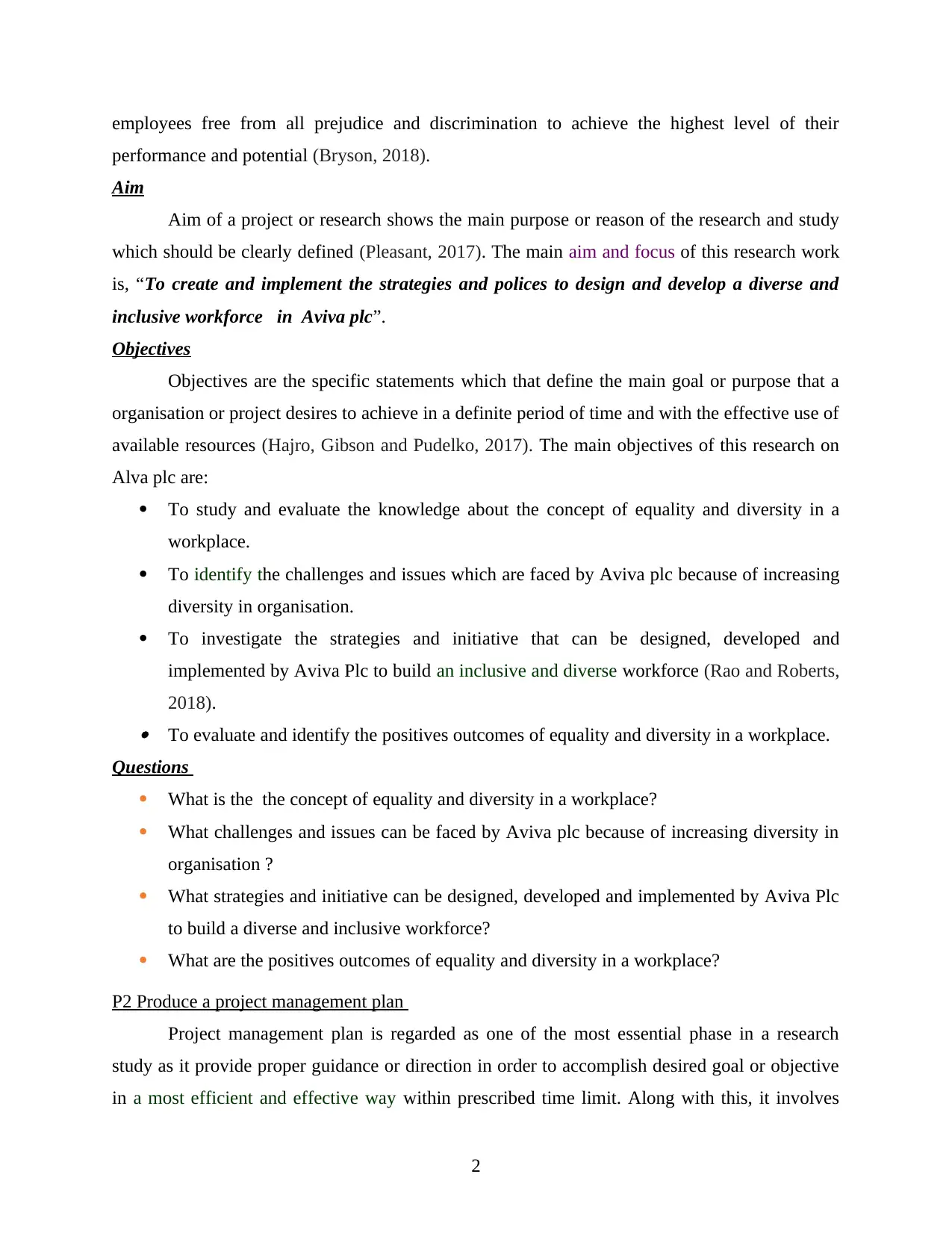
employees free from all prejudice and discrimination to achieve the highest level of their
performance and potential (Bryson, 2018).
Aim
Aim of a project or research shows the main purpose or reason of the research and study
which should be clearly defined (Pleasant, 2017). The main aim and focus of this research work
is, “To create and implement the strategies and polices to design and develop a diverse and
inclusive workforce in Aviva plc”.
Objectives
Objectives are the specific statements which that define the main goal or purpose that a
organisation or project desires to achieve in a definite period of time and with the effective use of
available resources (Hajro, Gibson and Pudelko, 2017). The main objectives of this research on
Alva plc are:
To study and evaluate the knowledge about the concept of equality and diversity in a
workplace.
To identify the challenges and issues which are faced by Aviva plc because of increasing
diversity in organisation.
To investigate the strategies and initiative that can be designed, developed and
implemented by Aviva Plc to build an inclusive and diverse workforce (Rao and Roberts,
2018). To evaluate and identify the positives outcomes of equality and diversity in a workplace.
Questions
What is the the concept of equality and diversity in a workplace?
What challenges and issues can be faced by Aviva plc because of increasing diversity in
organisation ?
What strategies and initiative can be designed, developed and implemented by Aviva Plc
to build a diverse and inclusive workforce?
What are the positives outcomes of equality and diversity in a workplace?
P2 Produce a project management plan
Project management plan is regarded as one of the most essential phase in a research
study as it provide proper guidance or direction in order to accomplish desired goal or objective
in a most efficient and effective way within prescribed time limit. Along with this, it involves
2
performance and potential (Bryson, 2018).
Aim
Aim of a project or research shows the main purpose or reason of the research and study
which should be clearly defined (Pleasant, 2017). The main aim and focus of this research work
is, “To create and implement the strategies and polices to design and develop a diverse and
inclusive workforce in Aviva plc”.
Objectives
Objectives are the specific statements which that define the main goal or purpose that a
organisation or project desires to achieve in a definite period of time and with the effective use of
available resources (Hajro, Gibson and Pudelko, 2017). The main objectives of this research on
Alva plc are:
To study and evaluate the knowledge about the concept of equality and diversity in a
workplace.
To identify the challenges and issues which are faced by Aviva plc because of increasing
diversity in organisation.
To investigate the strategies and initiative that can be designed, developed and
implemented by Aviva Plc to build an inclusive and diverse workforce (Rao and Roberts,
2018). To evaluate and identify the positives outcomes of equality and diversity in a workplace.
Questions
What is the the concept of equality and diversity in a workplace?
What challenges and issues can be faced by Aviva plc because of increasing diversity in
organisation ?
What strategies and initiative can be designed, developed and implemented by Aviva Plc
to build a diverse and inclusive workforce?
What are the positives outcomes of equality and diversity in a workplace?
P2 Produce a project management plan
Project management plan is regarded as one of the most essential phase in a research
study as it provide proper guidance or direction in order to accomplish desired goal or objective
in a most efficient and effective way within prescribed time limit. Along with this, it involves
2
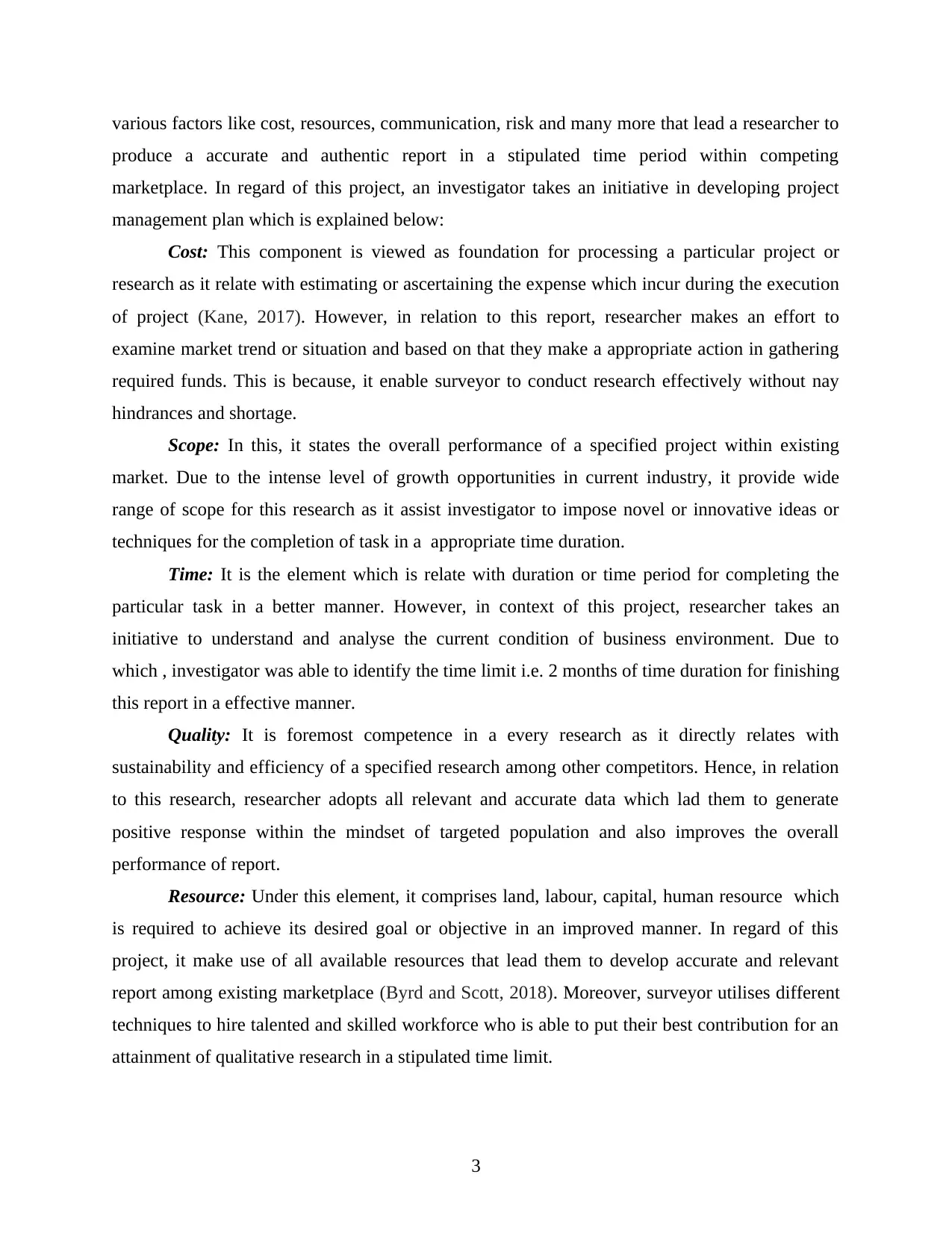
various factors like cost, resources, communication, risk and many more that lead a researcher to
produce a accurate and authentic report in a stipulated time period within competing
marketplace. In regard of this project, an investigator takes an initiative in developing project
management plan which is explained below:
Cost: This component is viewed as foundation for processing a particular project or
research as it relate with estimating or ascertaining the expense which incur during the execution
of project (Kane, 2017). However, in relation to this report, researcher makes an effort to
examine market trend or situation and based on that they make a appropriate action in gathering
required funds. This is because, it enable surveyor to conduct research effectively without nay
hindrances and shortage.
Scope: In this, it states the overall performance of a specified project within existing
market. Due to the intense level of growth opportunities in current industry, it provide wide
range of scope for this research as it assist investigator to impose novel or innovative ideas or
techniques for the completion of task in a appropriate time duration.
Time: It is the element which is relate with duration or time period for completing the
particular task in a better manner. However, in context of this project, researcher takes an
initiative to understand and analyse the current condition of business environment. Due to
which , investigator was able to identify the time limit i.e. 2 months of time duration for finishing
this report in a effective manner.
Quality: It is foremost competence in a every research as it directly relates with
sustainability and efficiency of a specified research among other competitors. Hence, in relation
to this research, researcher adopts all relevant and accurate data which lad them to generate
positive response within the mindset of targeted population and also improves the overall
performance of report.
Resource: Under this element, it comprises land, labour, capital, human resource which
is required to achieve its desired goal or objective in an improved manner. In regard of this
project, it make use of all available resources that lead them to develop accurate and relevant
report among existing marketplace (Byrd and Scott, 2018). Moreover, surveyor utilises different
techniques to hire talented and skilled workforce who is able to put their best contribution for an
attainment of qualitative research in a stipulated time limit.
3
produce a accurate and authentic report in a stipulated time period within competing
marketplace. In regard of this project, an investigator takes an initiative in developing project
management plan which is explained below:
Cost: This component is viewed as foundation for processing a particular project or
research as it relate with estimating or ascertaining the expense which incur during the execution
of project (Kane, 2017). However, in relation to this report, researcher makes an effort to
examine market trend or situation and based on that they make a appropriate action in gathering
required funds. This is because, it enable surveyor to conduct research effectively without nay
hindrances and shortage.
Scope: In this, it states the overall performance of a specified project within existing
market. Due to the intense level of growth opportunities in current industry, it provide wide
range of scope for this research as it assist investigator to impose novel or innovative ideas or
techniques for the completion of task in a appropriate time duration.
Time: It is the element which is relate with duration or time period for completing the
particular task in a better manner. However, in context of this project, researcher takes an
initiative to understand and analyse the current condition of business environment. Due to
which , investigator was able to identify the time limit i.e. 2 months of time duration for finishing
this report in a effective manner.
Quality: It is foremost competence in a every research as it directly relates with
sustainability and efficiency of a specified research among other competitors. Hence, in relation
to this research, researcher adopts all relevant and accurate data which lad them to generate
positive response within the mindset of targeted population and also improves the overall
performance of report.
Resource: Under this element, it comprises land, labour, capital, human resource which
is required to achieve its desired goal or objective in an improved manner. In regard of this
project, it make use of all available resources that lead them to develop accurate and relevant
report among existing marketplace (Byrd and Scott, 2018). Moreover, surveyor utilises different
techniques to hire talented and skilled workforce who is able to put their best contribution for an
attainment of qualitative research in a stipulated time limit.
3
⊘ This is a preview!⊘
Do you want full access?
Subscribe today to unlock all pages.

Trusted by 1+ million students worldwide
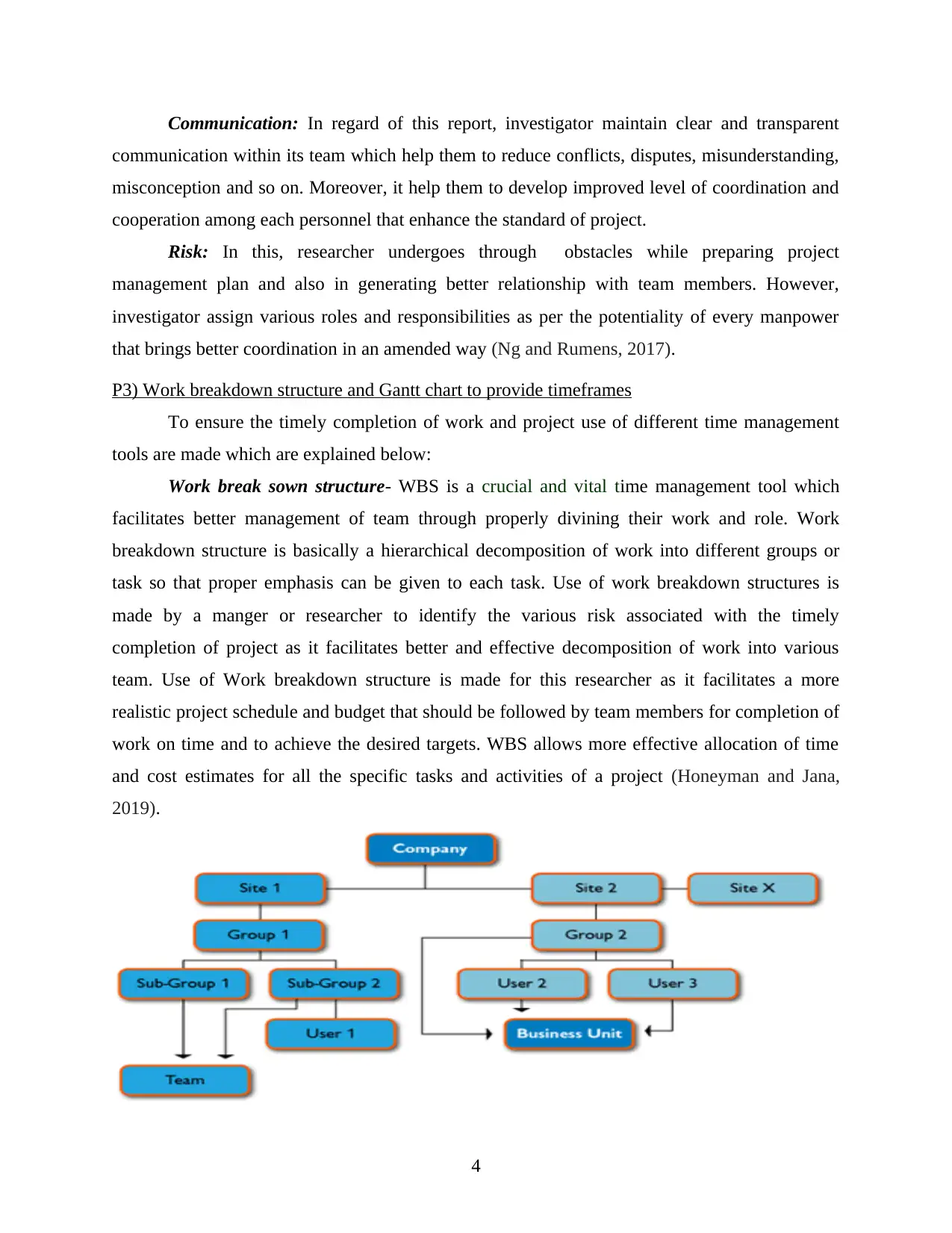
Communication: In regard of this report, investigator maintain clear and transparent
communication within its team which help them to reduce conflicts, disputes, misunderstanding,
misconception and so on. Moreover, it help them to develop improved level of coordination and
cooperation among each personnel that enhance the standard of project.
Risk: In this, researcher undergoes through obstacles while preparing project
management plan and also in generating better relationship with team members. However,
investigator assign various roles and responsibilities as per the potentiality of every manpower
that brings better coordination in an amended way (Ng and Rumens, 2017).
P3) Work breakdown structure and Gantt chart to provide timeframes
To ensure the timely completion of work and project use of different time management
tools are made which are explained below:
Work break sown structure- WBS is a crucial and vital time management tool which
facilitates better management of team through properly divining their work and role. Work
breakdown structure is basically a hierarchical decomposition of work into different groups or
task so that proper emphasis can be given to each task. Use of work breakdown structures is
made by a manger or researcher to identify the various risk associated with the timely
completion of project as it facilitates better and effective decomposition of work into various
team. Use of Work breakdown structure is made for this researcher as it facilitates a more
realistic project schedule and budget that should be followed by team members for completion of
work on time and to achieve the desired targets. WBS allows more effective allocation of time
and cost estimates for all the specific tasks and activities of a project (Honeyman and Jana,
2019).
4
communication within its team which help them to reduce conflicts, disputes, misunderstanding,
misconception and so on. Moreover, it help them to develop improved level of coordination and
cooperation among each personnel that enhance the standard of project.
Risk: In this, researcher undergoes through obstacles while preparing project
management plan and also in generating better relationship with team members. However,
investigator assign various roles and responsibilities as per the potentiality of every manpower
that brings better coordination in an amended way (Ng and Rumens, 2017).
P3) Work breakdown structure and Gantt chart to provide timeframes
To ensure the timely completion of work and project use of different time management
tools are made which are explained below:
Work break sown structure- WBS is a crucial and vital time management tool which
facilitates better management of team through properly divining their work and role. Work
breakdown structure is basically a hierarchical decomposition of work into different groups or
task so that proper emphasis can be given to each task. Use of work breakdown structures is
made by a manger or researcher to identify the various risk associated with the timely
completion of project as it facilitates better and effective decomposition of work into various
team. Use of Work breakdown structure is made for this researcher as it facilitates a more
realistic project schedule and budget that should be followed by team members for completion of
work on time and to achieve the desired targets. WBS allows more effective allocation of time
and cost estimates for all the specific tasks and activities of a project (Honeyman and Jana,
2019).
4
Paraphrase This Document
Need a fresh take? Get an instant paraphrase of this document with our AI Paraphraser
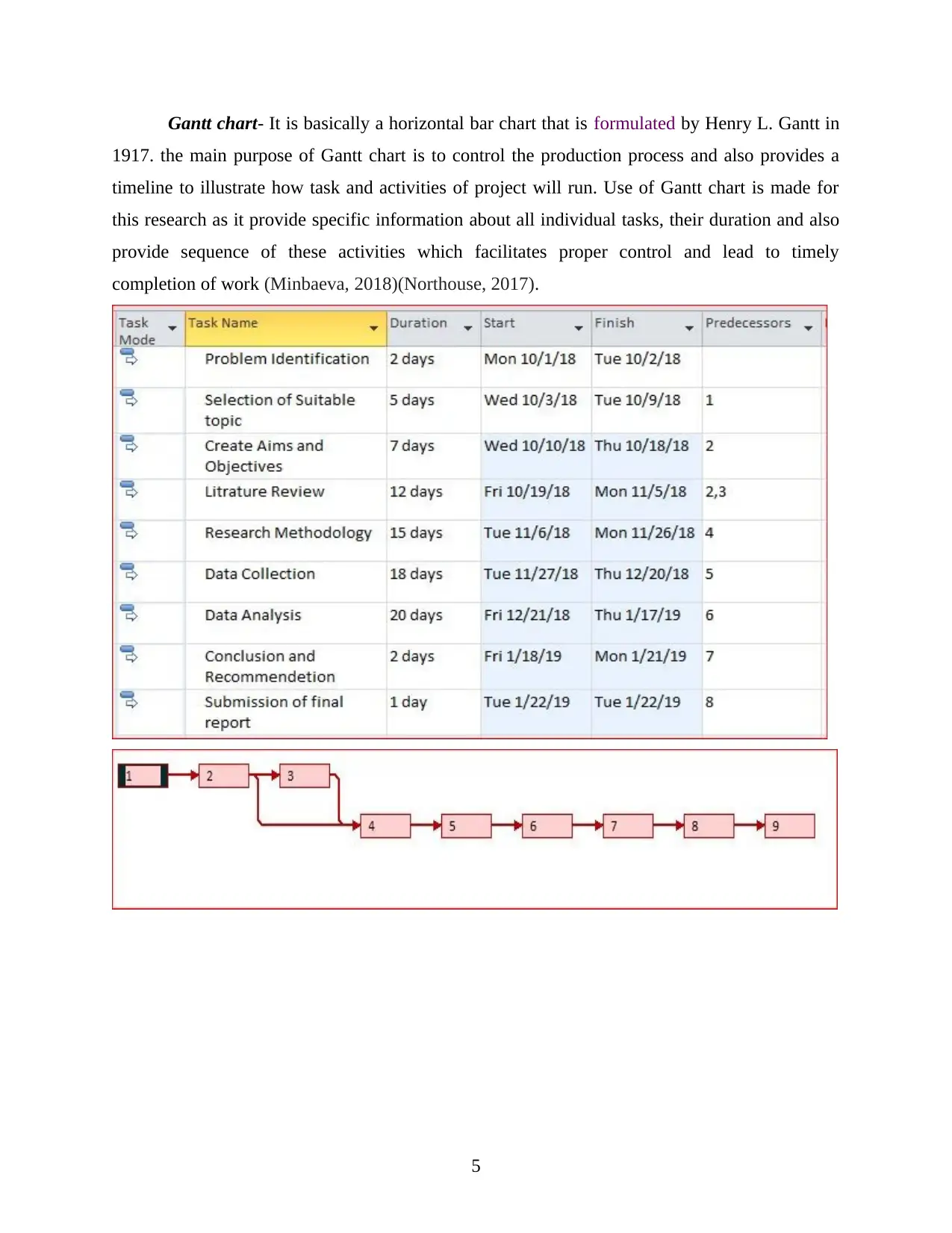
Gantt chart- It is basically a horizontal bar chart that is formulated by Henry L. Gantt in
1917. the main purpose of Gantt chart is to control the production process and also provides a
timeline to illustrate how task and activities of project will run. Use of Gantt chart is made for
this research as it provide specific information about all individual tasks, their duration and also
provide sequence of these activities which facilitates proper control and lead to timely
completion of work (Minbaeva, 2018)(Northouse, 2017).
5
1917. the main purpose of Gantt chart is to control the production process and also provides a
timeline to illustrate how task and activities of project will run. Use of Gantt chart is made for
this research as it provide specific information about all individual tasks, their duration and also
provide sequence of these activities which facilitates proper control and lead to timely
completion of work (Minbaeva, 2018)(Northouse, 2017).
5
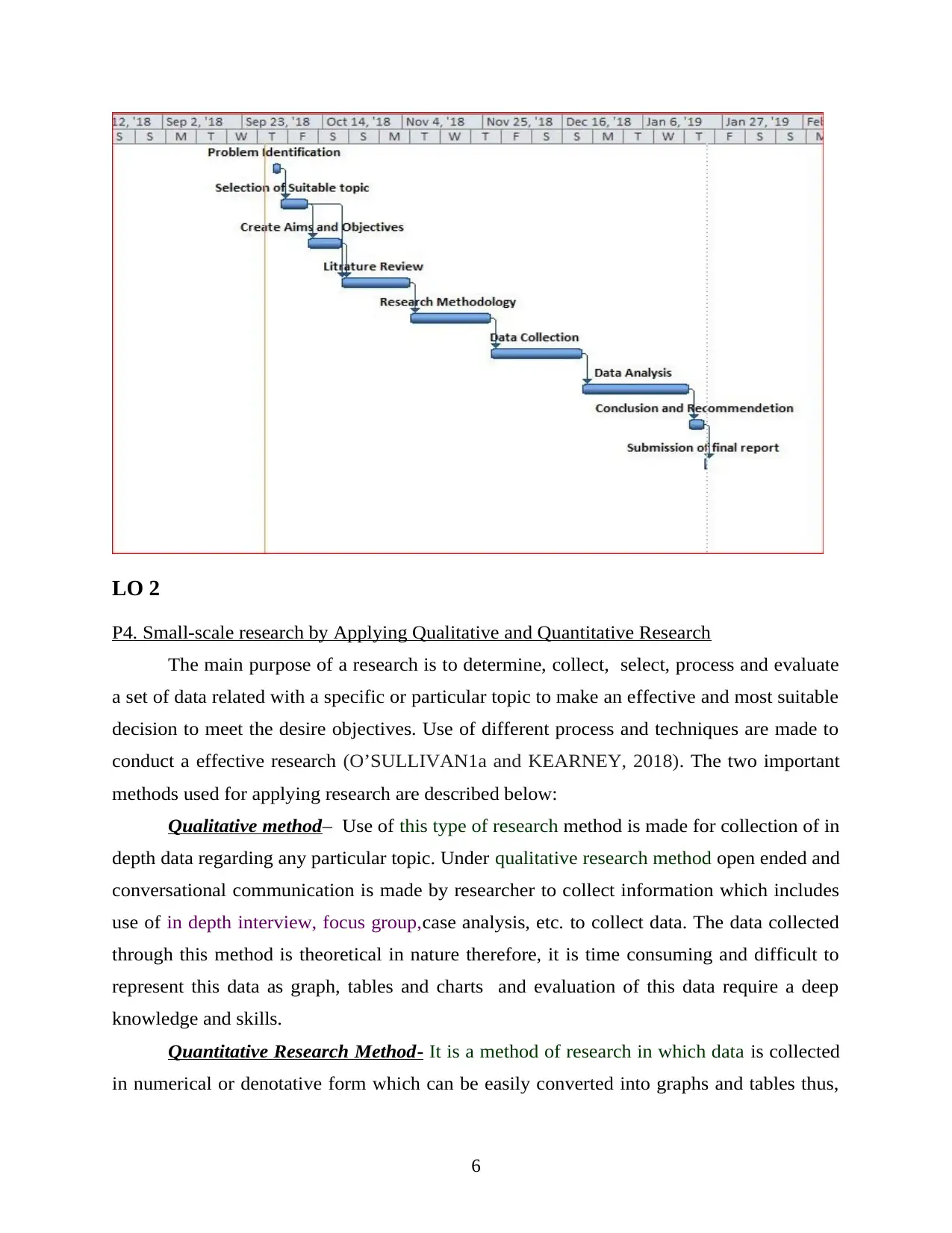
LO 2
P4. Small-scale research by Applying Qualitative and Quantitative Research
The main purpose of a research is to determine, collect, select, process and evaluate
a set of data related with a specific or particular topic to make an effective and most suitable
decision to meet the desire objectives. Use of different process and techniques are made to
conduct a effective research (O’SULLIVAN1a and KEARNEY, 2018). The two important
methods used for applying research are described below:
Qualitative method– Use of this type of research method is made for collection of in
depth data regarding any particular topic. Under qualitative research method open ended and
conversational communication is made by researcher to collect information which includes
use of in depth interview, focus group,case analysis, etc. to collect data. The data collected
through this method is theoretical in nature therefore, it is time consuming and difficult to
represent this data as graph, tables and charts and evaluation of this data require a deep
knowledge and skills.
Quantitative Research Method- It is a method of research in which data is collected
in numerical or denotative form which can be easily converted into graphs and tables thus,
6
P4. Small-scale research by Applying Qualitative and Quantitative Research
The main purpose of a research is to determine, collect, select, process and evaluate
a set of data related with a specific or particular topic to make an effective and most suitable
decision to meet the desire objectives. Use of different process and techniques are made to
conduct a effective research (O’SULLIVAN1a and KEARNEY, 2018). The two important
methods used for applying research are described below:
Qualitative method– Use of this type of research method is made for collection of in
depth data regarding any particular topic. Under qualitative research method open ended and
conversational communication is made by researcher to collect information which includes
use of in depth interview, focus group,case analysis, etc. to collect data. The data collected
through this method is theoretical in nature therefore, it is time consuming and difficult to
represent this data as graph, tables and charts and evaluation of this data require a deep
knowledge and skills.
Quantitative Research Method- It is a method of research in which data is collected
in numerical or denotative form which can be easily converted into graphs and tables thus,
6
⊘ This is a preview!⊘
Do you want full access?
Subscribe today to unlock all pages.

Trusted by 1+ million students worldwide
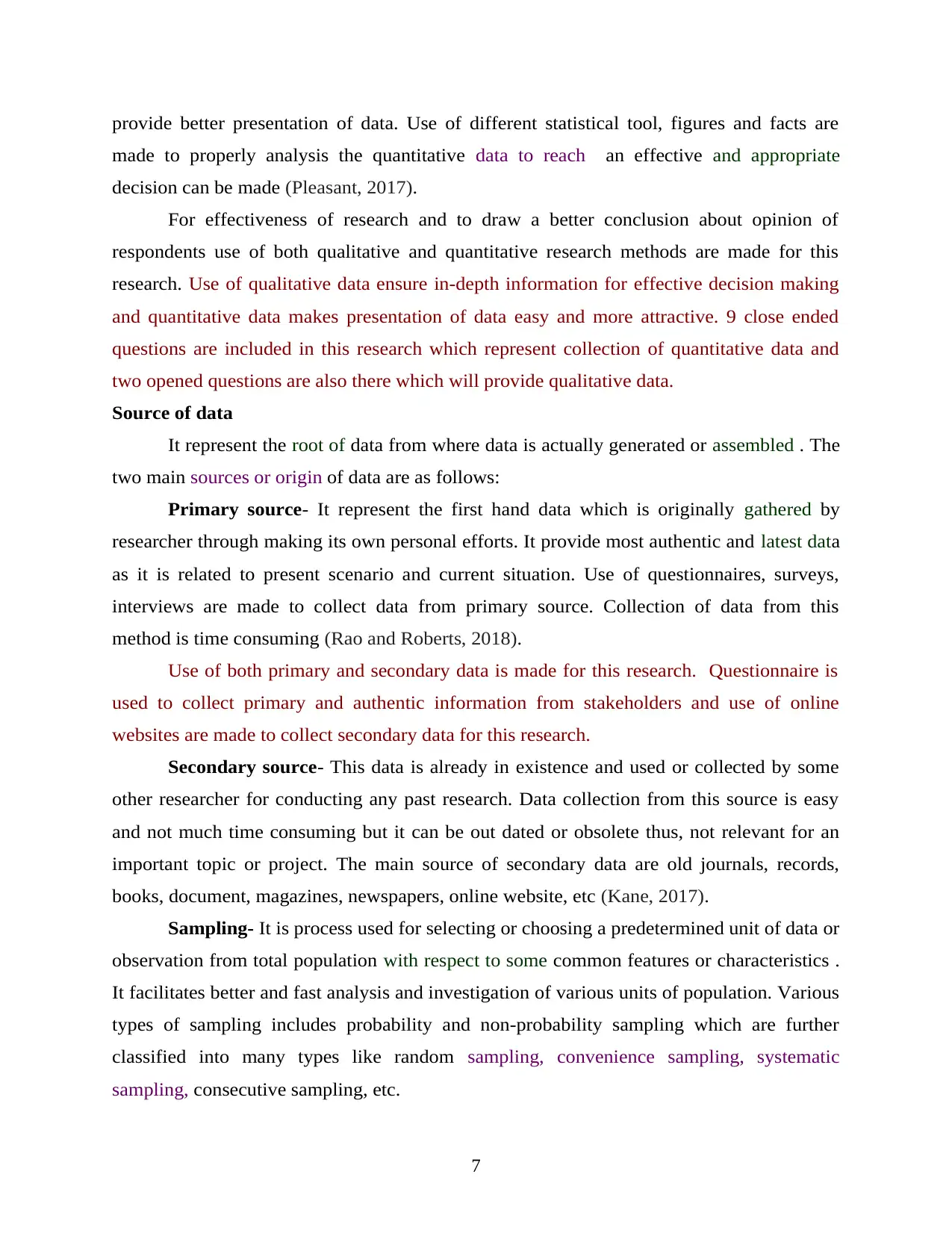
provide better presentation of data. Use of different statistical tool, figures and facts are
made to properly analysis the quantitative data to reach an effective and appropriate
decision can be made (Pleasant, 2017).
For effectiveness of research and to draw a better conclusion about opinion of
respondents use of both qualitative and quantitative research methods are made for this
research. Use of qualitative data ensure in-depth information for effective decision making
and quantitative data makes presentation of data easy and more attractive. 9 close ended
questions are included in this research which represent collection of quantitative data and
two opened questions are also there which will provide qualitative data.
Source of data
It represent the root of data from where data is actually generated or assembled . The
two main sources or origin of data are as follows:
Primary source- It represent the first hand data which is originally gathered by
researcher through making its own personal efforts. It provide most authentic and latest data
as it is related to present scenario and current situation. Use of questionnaires, surveys,
interviews are made to collect data from primary source. Collection of data from this
method is time consuming (Rao and Roberts, 2018).
Use of both primary and secondary data is made for this research. Questionnaire is
used to collect primary and authentic information from stakeholders and use of online
websites are made to collect secondary data for this research.
Secondary source- This data is already in existence and used or collected by some
other researcher for conducting any past research. Data collection from this source is easy
and not much time consuming but it can be out dated or obsolete thus, not relevant for an
important topic or project. The main source of secondary data are old journals, records,
books, document, magazines, newspapers, online website, etc (Kane, 2017).
Sampling- It is process used for selecting or choosing a predetermined unit of data or
observation from total population with respect to some common features or characteristics .
It facilitates better and fast analysis and investigation of various units of population. Various
types of sampling includes probability and non-probability sampling which are further
classified into many types like random sampling, convenience sampling, systematic
sampling, consecutive sampling, etc.
7
made to properly analysis the quantitative data to reach an effective and appropriate
decision can be made (Pleasant, 2017).
For effectiveness of research and to draw a better conclusion about opinion of
respondents use of both qualitative and quantitative research methods are made for this
research. Use of qualitative data ensure in-depth information for effective decision making
and quantitative data makes presentation of data easy and more attractive. 9 close ended
questions are included in this research which represent collection of quantitative data and
two opened questions are also there which will provide qualitative data.
Source of data
It represent the root of data from where data is actually generated or assembled . The
two main sources or origin of data are as follows:
Primary source- It represent the first hand data which is originally gathered by
researcher through making its own personal efforts. It provide most authentic and latest data
as it is related to present scenario and current situation. Use of questionnaires, surveys,
interviews are made to collect data from primary source. Collection of data from this
method is time consuming (Rao and Roberts, 2018).
Use of both primary and secondary data is made for this research. Questionnaire is
used to collect primary and authentic information from stakeholders and use of online
websites are made to collect secondary data for this research.
Secondary source- This data is already in existence and used or collected by some
other researcher for conducting any past research. Data collection from this source is easy
and not much time consuming but it can be out dated or obsolete thus, not relevant for an
important topic or project. The main source of secondary data are old journals, records,
books, document, magazines, newspapers, online website, etc (Kane, 2017).
Sampling- It is process used for selecting or choosing a predetermined unit of data or
observation from total population with respect to some common features or characteristics .
It facilitates better and fast analysis and investigation of various units of population. Various
types of sampling includes probability and non-probability sampling which are further
classified into many types like random sampling, convenience sampling, systematic
sampling, consecutive sampling, etc.
7
Paraphrase This Document
Need a fresh take? Get an instant paraphrase of this document with our AI Paraphraser
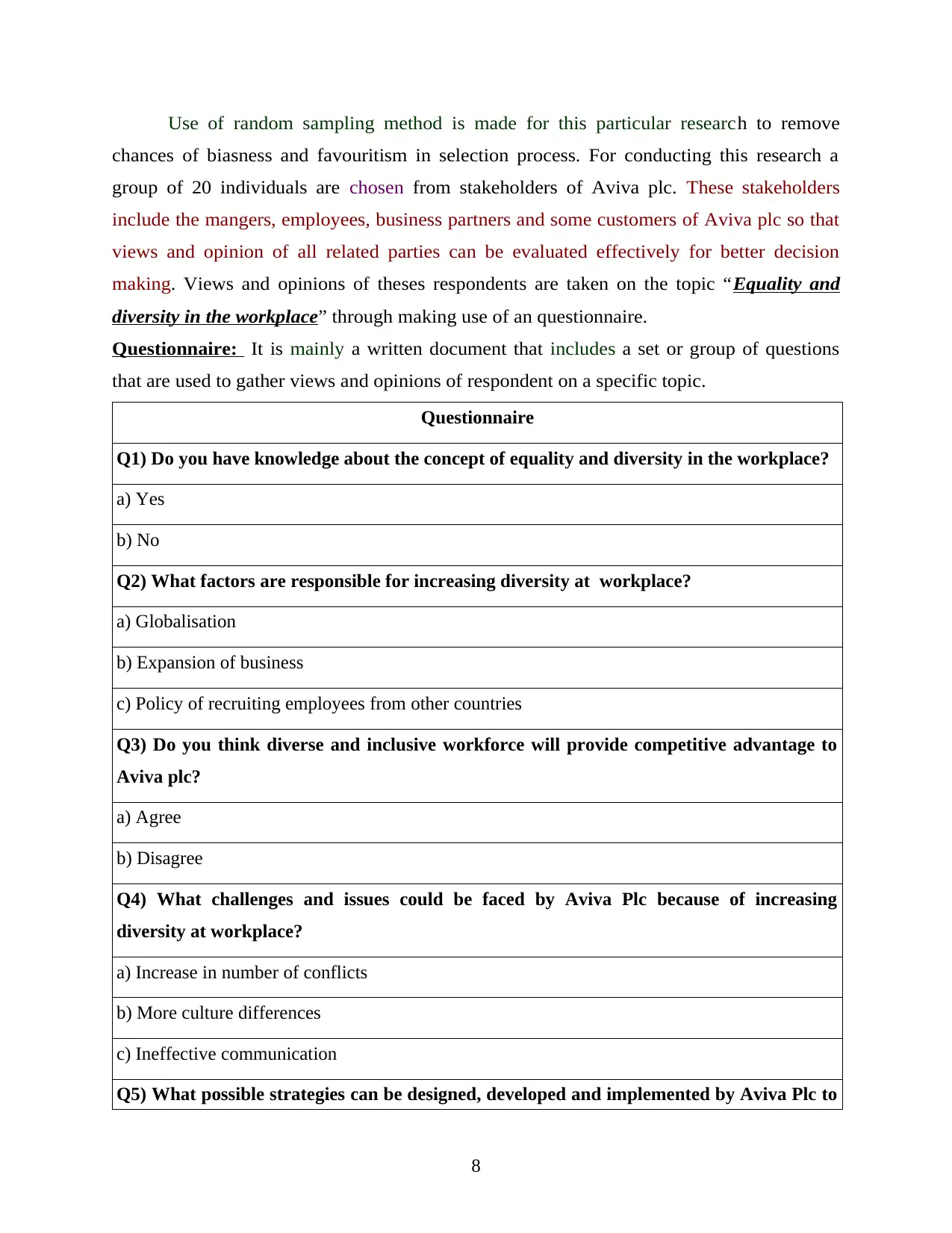
Use of random sampling method is made for this particular research to remove
chances of biasness and favouritism in selection process. For conducting this research a
group of 20 individuals are chosen from stakeholders of Aviva plc. These stakeholders
include the mangers, employees, business partners and some customers of Aviva plc so that
views and opinion of all related parties can be evaluated effectively for better decision
making. Views and opinions of theses respondents are taken on the topic “Equality and
diversity in the workplace” through making use of an questionnaire.
Questionnaire: It is mainly a written document that includes a set or group of questions
that are used to gather views and opinions of respondent on a specific topic.
Questionnaire
Q1) Do you have knowledge about the concept of equality and diversity in the workplace?
a) Yes
b) No
Q2) What factors are responsible for increasing diversity at workplace?
a) Globalisation
b) Expansion of business
c) Policy of recruiting employees from other countries
Q3) Do you think diverse and inclusive workforce will provide competitive advantage to
Aviva plc?
a) Agree
b) Disagree
Q4) What challenges and issues could be faced by Aviva Plc because of increasing
diversity at workplace?
a) Increase in number of conflicts
b) More culture differences
c) Ineffective communication
Q5) What possible strategies can be designed, developed and implemented by Aviva Plc to
8
chances of biasness and favouritism in selection process. For conducting this research a
group of 20 individuals are chosen from stakeholders of Aviva plc. These stakeholders
include the mangers, employees, business partners and some customers of Aviva plc so that
views and opinion of all related parties can be evaluated effectively for better decision
making. Views and opinions of theses respondents are taken on the topic “Equality and
diversity in the workplace” through making use of an questionnaire.
Questionnaire: It is mainly a written document that includes a set or group of questions
that are used to gather views and opinions of respondent on a specific topic.
Questionnaire
Q1) Do you have knowledge about the concept of equality and diversity in the workplace?
a) Yes
b) No
Q2) What factors are responsible for increasing diversity at workplace?
a) Globalisation
b) Expansion of business
c) Policy of recruiting employees from other countries
Q3) Do you think diverse and inclusive workforce will provide competitive advantage to
Aviva plc?
a) Agree
b) Disagree
Q4) What challenges and issues could be faced by Aviva Plc because of increasing
diversity at workplace?
a) Increase in number of conflicts
b) More culture differences
c) Ineffective communication
Q5) What possible strategies can be designed, developed and implemented by Aviva Plc to
8
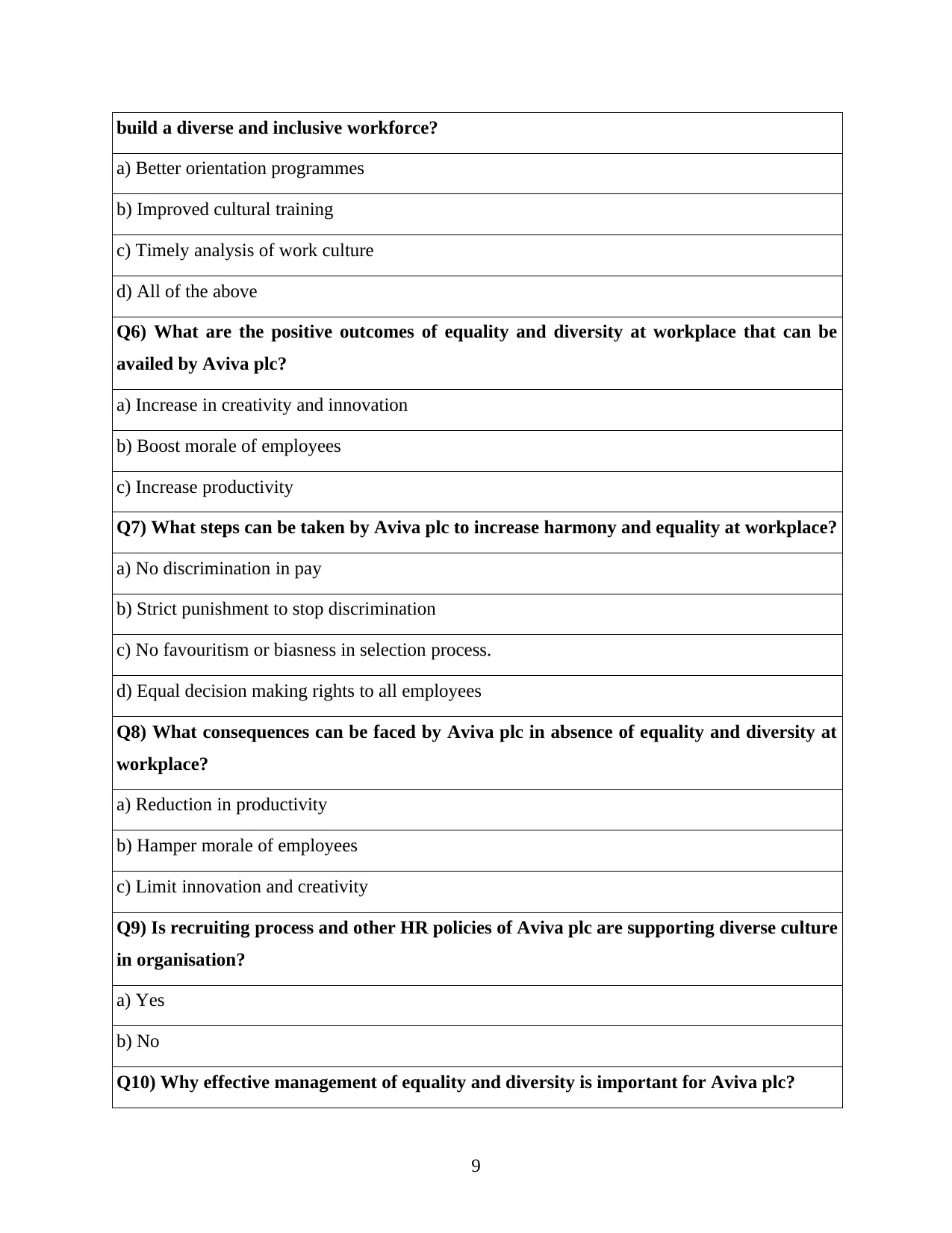
build a diverse and inclusive workforce?
a) Better orientation programmes
b) Improved cultural training
c) Timely analysis of work culture
d) All of the above
Q6) What are the positive outcomes of equality and diversity at workplace that can be
availed by Aviva plc?
a) Increase in creativity and innovation
b) Boost morale of employees
c) Increase productivity
Q7) What steps can be taken by Aviva plc to increase harmony and equality at workplace?
a) No discrimination in pay
b) Strict punishment to stop discrimination
c) No favouritism or biasness in selection process.
d) Equal decision making rights to all employees
Q8) What consequences can be faced by Aviva plc in absence of equality and diversity at
workplace?
a) Reduction in productivity
b) Hamper morale of employees
c) Limit innovation and creativity
Q9) Is recruiting process and other HR policies of Aviva plc are supporting diverse culture
in organisation?
a) Yes
b) No
Q10) Why effective management of equality and diversity is important for Aviva plc?
9
a) Better orientation programmes
b) Improved cultural training
c) Timely analysis of work culture
d) All of the above
Q6) What are the positive outcomes of equality and diversity at workplace that can be
availed by Aviva plc?
a) Increase in creativity and innovation
b) Boost morale of employees
c) Increase productivity
Q7) What steps can be taken by Aviva plc to increase harmony and equality at workplace?
a) No discrimination in pay
b) Strict punishment to stop discrimination
c) No favouritism or biasness in selection process.
d) Equal decision making rights to all employees
Q8) What consequences can be faced by Aviva plc in absence of equality and diversity at
workplace?
a) Reduction in productivity
b) Hamper morale of employees
c) Limit innovation and creativity
Q9) Is recruiting process and other HR policies of Aviva plc are supporting diverse culture
in organisation?
a) Yes
b) No
Q10) Why effective management of equality and diversity is important for Aviva plc?
9
⊘ This is a preview!⊘
Do you want full access?
Subscribe today to unlock all pages.

Trusted by 1+ million students worldwide
1 out of 27
Related Documents
Your All-in-One AI-Powered Toolkit for Academic Success.
+13062052269
info@desklib.com
Available 24*7 on WhatsApp / Email
![[object Object]](/_next/static/media/star-bottom.7253800d.svg)
Unlock your academic potential
Copyright © 2020–2025 A2Z Services. All Rights Reserved. Developed and managed by ZUCOL.




